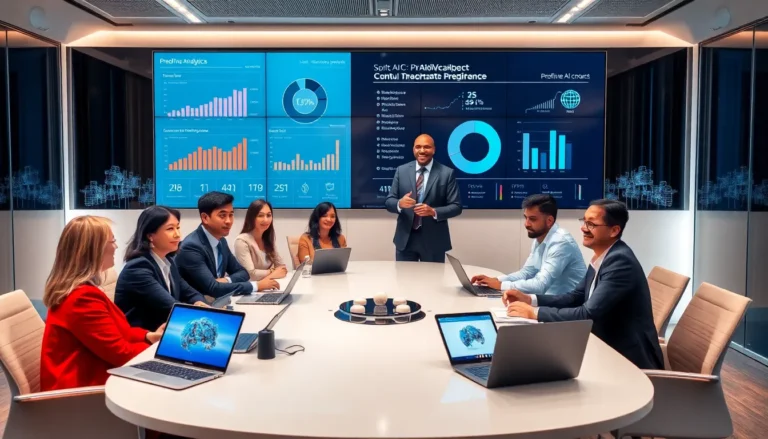Table of Contents
ToggleIn today’s tech-savvy world, understanding the buzzwords is key to staying ahead. Enter SaaS, or Software as a Service, the superhero of software delivery. Imagine having access to your favorite applications without the hassle of installation or updates. It’s like having a magic genie that grants you software wishes from the cloud, saving time and sanity.
SaaS isn’t just a trendy acronym; it’s transformed how businesses operate. With its subscription-based model, companies can scale effortlessly while keeping costs in check. No more worrying about outdated software or compatibility issues—SaaS has got it covered. Dive into the world of SaaS and discover how it’s reshaping industries, one cloud-based solution at a time. Who knew software could be this much fun?
Understanding SaaS Meaning
Software as a Service (SaaS) represents an innovative method for delivering software applications through the cloud. Users access these applications via the internet, which eliminates the need for local installation or constant updates. This model significantly enhances efficiency, allowing businesses to focus on core operations.
A subscription-based pricing structure characterizes SaaS, granting organizations flexibility in managing costs. With tiered pricing options, it accommodates various business sizes and needs. As a result, companies can easily scale their usage according to their growth trajectory.
SaaS addresses critical concerns regarding software maintenance and compatibility. Updates occur automatically, ensuring users benefit from the latest features without manual installation. Compatibility with devices becomes irrelevant, as access occurs through a web browser.
In addition, the cloud infrastructure underlying SaaS promotes collaboration. Teams can work together in real-time, regardless of their physical locations. This level of connectivity supports more dynamic workflows and enhances productivity.
The landscape of industries shifts dramatically with SaaS solutions at the forefront. From CRM systems to project management tools, organizations leverage these applications to streamline their operations. Through decreased IT responsibilities and improved collaboration, SaaS has fundamentally changed how businesses operate in the digital age.
Key Characteristics of SaaS

SaaS exhibits several key characteristics that distinguish it from traditional software delivery methods. Understanding these features provides clarity on its growing adoption.
Cloud-Based Delivery
SaaS applications operate primarily in the cloud. This arrangement removes the need for local installations, streamlining access through a web browser. Users access applications from any device with internet connectivity, enhancing flexibility. Cloud-based delivery supports real-time updates. Automatic updates ensure software remains current without user intervention. This model eliminates compatibility issues, allowing diverse devices to work seamlessly with the same application.
Subscription Pricing Model
SaaS utilizes a subscription pricing model. Organizations pay a recurring fee, which fosters cost predictability. This model reduces the upfront costs typically associated with traditional software licenses. Subscription plans vary, offering options that cater to different business sizes. A range of features can come with each plan, allowing businesses to select what best fits their needs. Flexibility in subscription tiers enables easy scaling, accommodating growing user bases or changing demands.
Advantages of SaaS
SaaS offers numerous benefits, contributing to its rapid adoption across various industries.
Cost-Effectiveness
Cost-effectiveness ranks among the top advantages of SaaS. Users incur lower upfront costs since they purchase subscriptions rather than full software licenses. This model allows businesses to manage budgets more effectively, avoiding hefty initial investments. Additionally, maintenance and infrastructure costs reduce significantly, as the service provider handles updates and server management. Businesses can allocate these saved resources toward growth and development efforts. Flexible subscription options enable firms to choose plans that align with their needs, enhancing financial efficiency.
Scalability and Accessibility
Scalability and accessibility stand out as critical strengths of SaaS. Organizations can effortlessly scale services up or down according to demand, ensuring they only pay for what they use. This adaptability is crucial for businesses experiencing fluctuating workloads or rapid growth. Moreover, online access allows users to connect from any device with internet availability, fostering collaboration regardless of location. Real-time updates further enhance user experience, ensuring everyone works with the latest features and data. This level of accessibility supports diverse work environments, increasing overall productivity and teamwork.
Challenges of SaaS
SaaS offers many benefits, yet it also faces distinct challenges that organizations must navigate.
Security Concerns
Security remains a top concern for businesses adopting SaaS solutions. Data breaches can occur if sensitive information isn’t adequately protected. Organizations may lack control over data stored in third-party servers, increasing vulnerability. Compliance with regulations like GDPR and HIPAA can pose additional challenges, as providers must ensure their services meet legal requirements. Regular security audits and thorough vetting of providers enhance trust. Users should prioritize choosing SaaS applications that offer robust security features, such as encryption and multi-factor authentication.
Downtime Risks
Downtime poses significant risks to organizations utilizing SaaS. Service outages can disrupt business operations, impacting productivity and customer satisfaction. While providers strive to maintain reliable uptime, occasional interruptions can occur due to server maintenance or unexpected failures. It’s crucial for businesses to evaluate a provider’s service level agreements (SLAs), which outline uptime commitments and response times during outages. Implementing backup solutions can mitigate downtime effects. Users should also develop contingency plans to ensure operations remain smooth during unforeseen disruptions.
Future of SaaS
The future of Software as a Service (SaaS) appears bright, with continuous growth expected in various sectors. Analysts predict the market for SaaS will reach $386.14 billion by 2029, reflecting a compound annual growth rate of 18%. This expansion indicates businesses increasingly recognize the value of cloud-based solutions.
Innovations in artificial intelligence (AI) and machine learning (ML) are driving SaaS evolution. Providers are enhancing functionality and automating processes, which improves efficiency. SaaS applications may soon offer more personalized experiences through advanced analytics and dynamic recommendations.
Integration capabilities are becoming more robust, allowing seamless connections between multiple SaaS solutions. Organizations benefit as teams utilize various tools that communicate effectively, streamlining workflows and improving data accessibility. Enhanced integrations foster collaboration among departments and facilitate data-driven decision-making.
Security measures in SaaS are also advancing. Providers invest heavily in state-of-the-art security protocols to combat emerging threats. As a result, organizations gain more confidence in storing sensitive information in the cloud, adhering to compliance requirements more easily.
Demand for vertical-specific solutions is on the rise, addressing the unique needs of specific industries. Targeted SaaS applications are appearing in sectors from healthcare to finance, simplifying operations and increasing effectiveness. This focus encourages businesses to adopt tailored solutions, fostering competitive advantage.
Globalization contributes to SaaS’s increasing significance, enabling professionals from diverse locations to collaborate. Remote work and digital transformation are accelerating this trend, as organizations seek tools that support distributed teams. With access from any internet-enabled device, geographical limitations diminish.
Overall, the future of SaaS relies on innovation, integration, security, and industry-specific solutions, promising substantial benefits for organizations ready to embrace these advancements.
SaaS is transforming the way organizations approach software utilization. Its cloud-based model not only streamlines operations but also enhances collaboration and productivity. As businesses increasingly adopt SaaS solutions, they can enjoy the benefits of scalability and cost-effectiveness while minimizing IT burdens.
The ongoing advancements in technology ensure that SaaS will continue to evolve, offering innovative features and improved security. With the market projected to grow significantly, embracing SaaS can position organizations to thrive in a rapidly changing digital landscape. As they navigate this shift, the focus on tailored solutions and integration will be essential for maximizing the potential of SaaS applications.





